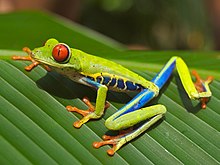

Motion camouflage is camouflage which provides a degree of concealment for a moving object, given that motion makes objects easy to detect however well their coloration matches their background or breaks up their outlines.
The principal form of motion camouflage, and the type generally meant by the term, involves an attacker's mimicking the optic flow of the background as seen by its target. This enables the attacker to approach the target while appearing to remain stationary from the target's perspective, unlike in classical pursuit (where the attacker moves straight towards the target at all times, and often appears to the target to move sideways). The attacker chooses its flight path so as to remain on the line between the target and some landmark point. The target therefore does not see the attacker move from the landmark point. The only visible evidence that the attacker is moving is its looming, the change in size as the attacker approaches.
Camouflage is sometimes facilitated by motion, as in the leafy sea dragon and some stick insects. These animals complement their passive camouflage by swaying like plants in the wind or ocean currents, delaying their recognition by predators.
First discovered in hoverflies in 1995, motion camouflage by minimising optic flow has been demonstrated in another insect order, dragonflies, as well as in two groups of vertebrates, falcons and echolocating bats. Since bats hunting at night cannot be using the strategy for camouflage, it has been named, describing its mechanism, as constant absolute target direction. This is an efficient homing strategy, and it has been suggested that anti-aircraft missiles could benefit from similar techniques.
© MMXXIII Rich X Search. We shall prevail. All rights reserved. Rich X Search
